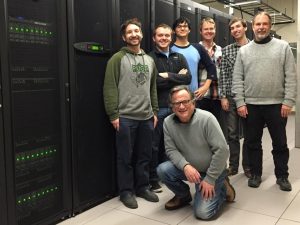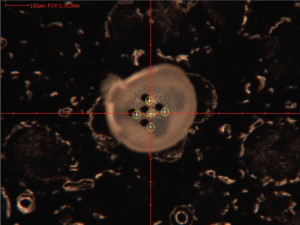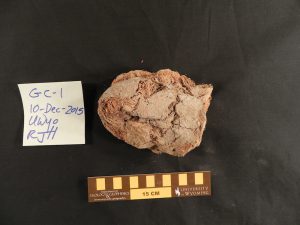October 17, 2018
A Passion for Paleontology: Going Beyond Brontosaurus
Posted by Laura Lyon
Today is the fourth day of Earth Science Week, National Fossil Day. We talked to paleontologists Hearth Ford of Queen Mary University of London, Ryan Haupt of the University of Wyoming, and Andrew Zaffos of the Arizona Geological Survey in the University of Arizona. Ryan has previously celebrated National Fossil Day with us here at The Bridge. Read his post here.
Fossils, the remains and traces of organisms, often invoke imagery of prehistoric forests and ferocious velociraptors. While giant dinosaurs such as the American Museum of Natural History’s 122-foot-long Titanosaur get the most attention, fossils come in all shapes and sizes! Most fossils are formed when an organism dies and is rapidly buried in sediment. Water seeping through the ground penetrates the remaining shell or bone, and eventually these remains are replaced with minerals from the water. Over time minerals build up and turn the shell or bone into stone, creating a fossil (for those interested the National Parks Service has a great FAQ). For National Fossil Day, we talked to three paleontologists who study fossils of different sizes using a variety of techniques.
Heather Ford is paleoceanographer and lecturer at Queen Mary University of London. She uses tiny fossils the size of a single grain of sand to explore the ocean’s history. Using the chemistry of these fossils, she can learn about the temperature and carbon properties of oceans in the past. Ryan Haupt is a paleontology PhD candidate and podcaster at the University of Wyoming. He studies the diet and ecology of fossil and modern sloths using proxy methods such as teeth surface texture and feces composition. Ryan summarizes it as “…trying to un-weird the weirdness that make up all things sloth.” Andrew Zaffos is a data scientist Arizona Geological Survey in the University of Arizona. He focuses on long-term trends of regional and global biodiversity. An example of his recent work is a study on the complex relationship between plate tectonics and the total number of species on the planet. These scientists want to show that paleontology is more than digging for bones, so today we will unearth the fascinating aspects of their research.
Benthic Bounty
“When I was in college, I learned I could use fossils to explore the history of the ocean or paleoceanography. I’ve been doing it since,” says Heather. She currently studies foraminifera which are protists that live in the ocean’s surface and sediment. They are ideal for paleoceanography because they’ve been around for approximately 500 million years and have become part of the ocean sediment archive. They form shells or “tests” out of calcium carbonate by adding new chambers to their shells as they grow, a process known as serial precipitation.
Using a mass spectrometer, Heather measures the elemental composition of these shells to estimate temperature and carbon properties of the ocean. She either measures the composition of several foraminifera by dissolving them in a weak acid or uses a laser to measure individuals. “This laser shoots the foraminifera’s chamber creating an aerosol which is measured by the mass spectrometer,” explains Heather. “The laser system is a new technique that helps us understand climate variability such as El Niño-Southern Oscillation or the Indian Monsoon.” Since foraminifera are found in most of the Ocean’s sediment archive, it is an ideal species to use as a proxy to study previous climates. “The ocean plays a huge role in the Earth’s climate so understanding the ocean in the past helps us understand the Earth’s past climates.”
Digging for Dung
To learn more about the diet of sloths, Ryan studies coprolites, the scientific term for fossilized poop. “[We collect] balls of ground sloth poop from Gypsum Cave in southern Nevada from about 30,000 to 11,000 years ago”, explains Ryan. “People think I’m exaggerating, but we have about half a dozen fossil sites in North America where the floor of the cave is basically a layer of sloth poop, sometimes along with the body of a Shasta ground sloth.” Unlike most coprolites, the grapefruit-sized dung of Shasta ground sloths (Nothrotheriops shastensis) never actually turned into rock – the cave’s extremely dry climate preserved them by removing moisture.
Due to the sloth’s inefficient digestion, there is a lot of data that can be extracted from coprolites. Ryan and his colleagues analyze both ancient and modern poop using stable isotope analyses to determine the amount of stable carbon in each sample. “What’s also great about this analysis is we can compare it to the stable isotope values from tissues in other fossil sloths without any associated coprolites, so it’s a really great way to put our special fossils into a broader context,” Though stable isotope analysis is not a new technique, prior to this work stable isotopes from neither coprolites nor modern feces have been compared to stable isotope data from other body parts of sloths. “Our hope is that this provides a more reliable result within our own study, but also helps refine how other sloth researchers are able to interpret their data as well.”
Crunching Coordinates

High-throughput computing servers at the Wisconsin Institute for Discovery.
Photo credit: Andrew Zaffos
Meanwhile Andrew works with the largest datasets he can find, with up to hundreds of thousands of specimens. He analyzes the location where the fossil was collected in the context of the ancient latitude and longitude of where it once lived. Calculating ancient coordinates is a complex, interdisciplinary endeavor. “Luckily for me, the paleogeography community has been great about putting out interactive tools like gplates that let you visualize and rotate continents to see where they were in the distant past,” says Andrew. Another resource is the Paleobiology Database, which is an online database of over 1.3 million fossil occurrences. “It covers every major animal group (and many plants) from every period in the history of complex animal life (550 million years),” explains Andrew. “It is a great resource that represents the hard work of hundreds of paleontologists over the past 20 years.” Combining these tools, he carried out his study on plate tectonics and species diversity.
Though most of his work is on the computer, he still breaks for fresh air. “I was just collecting mollusks in Grand Cayman with my colleague Kelsey Arkle and her students this summer!” They look at living, recently dead, and pre-historic fossil mollusks in the Caribbean to compare how they’ve changed over time among different islands. “This sort of multi-tiered view of time is one of the great advantages of working with fossil data and lets us connect our present human lives and environment with the deep past.”
Bigger than Bones
Paleontology is a truly interdisciplinary science – whether it’s climate studies, biology, or computer science, fossils have a variety of unique applications. “[A big] misconception is thinking that paleontologists only study dinosaurs,” says Ryan. “…I don’t want to diminish the work being done by my dino-focused colleagues, I just wish the public perception could broaden a bit to acknowledge everything else that’s happening in the field as well.”
There are also misconceptions about fossil collections. “I think some people think of paleontology as dusty collections in a basement somewhere, but there is so much history behind these collections from scientific and social perspective.” Not only have the fossils we study changed over time, but also who is able to study them. “My colleagues and I go to sea for a month at a time to collect our ocean sediment,” says Heather. “Women weren’t allowed on [research] boats until the 1950s and 1960s…” It is important to think of the history of fossil collecting, who curated these collections, and at what cost.
“Paleontology is an enormously varied discipline that requires expertise with both the physical and life sciences,” says Andrew. “A good paleontologist is always thinking about the bigger picture.”










